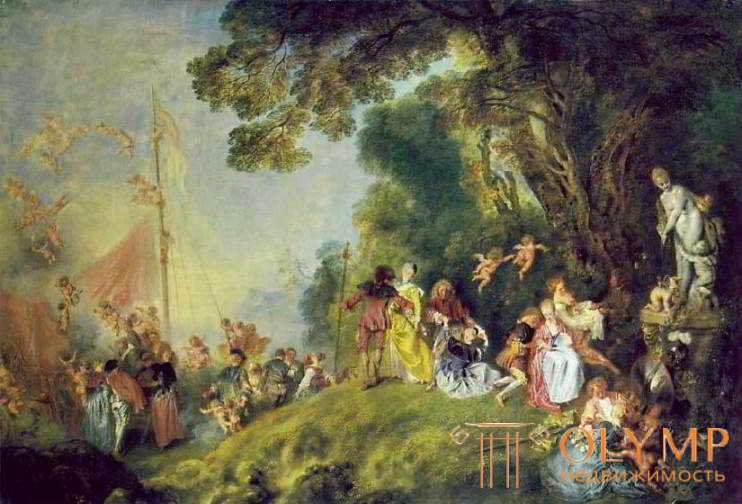
1. General overview of the development of painting
The formation of painting in this period is the key influence of the activities of the academies, especially the Royal Academy. In the 18th century, French painting confidently ranked first in Europe, influencing all other countries. During this period, there are many schools, often several generations of the same family are engaged in painting.
The influence of 18th century French painting on the taste of neighboring countries was even stronger than the influence of architecture and sculpture. Next to the academic direction, retaining the leading role in monumental painting and only slightly affected by the smaller and softer lines and brighter colors of the new time, a new joyful and flirty, with all his striving for naturalness, flourished, only in rare instances a non-obedient artistic direction. Inspired by the authentic old esprit gaulois, it conquered France and all of Europe. Only this, in the narrow sense of the word, French painting of the 18th century, absorbed eventually, although later than architecture and sculpture, by the flow of “infallible” neoclassicism, is important for the history of the development of styles. The artistic life then began to take shape in the field of painting in those forms in which it manifests itself even now. Academies, exhibitions, art criticism began to have a great influence on free artistic development. Along with the Royal Academy, which attracted the best forces, the Academy of St.. Luke in Paris, transformed from the old workshop of painters, only rarely boasted a brilliant name; and, along with the Paris Academy, the provincial art schools of higher education, of which the academies in Toulouse, Montpellier and Lyon took the first place, could, as a general rule, only satisfy local artistic needs. Only those "seconded" to the Royal Academy in Paris had the right to exhibit the Louvre in the Salon; a few years later, by the presentation of the “painting for the right to receive”, they received the title of ordinary academician. Reproach of one-sidedness, however, this academy does not deserve. She accepted among her fellows Claude Gillot, the teacher of Watteau, as a “painter of fashionable subjects”, Watteau himself as a “painter of festivities,” Dreaming as a “genre painter”; other artists are designated in her lists as landscape painters, painters of animals, flowers, etc. Along with academic exhibitions in the "square salon" and in the "big gallery" of the Louvre, regularly repeated since 1737 and reached its highest limit 89 the time of the appearance of famous "Salons" Diderot (1765–1767), also the Academy of St. Luke and the Youth Union organized their own exhibitions, which Dorbek pointed out.
In the new decorative and ornamental art, painting found itself mainly used in the painting of ceilings, walls and door panels, in painting furniture, fans, and soon porcelain. Miniature painting on ivory was becoming more and more fashionable. But the leading role belonged, nevertheless, to an easel painting; in portrait art, unexpected triumphs have now fallen, along with miniature painting, to the lot of pastels, gently laying on the extompom paints, painted in the form of strokes with colored pencils.
From the reproduction arts, an engraving on copper with all its varieties continued to flourish. Along with the engravers, who were still partly limited to reproducing other people's paintings, others engraved portraits, as they did in the 17th century, representatives of mezzotinto, transformed by hand of Franklin native Leblond (1667 to 1741), into a color engraving on copper with three or four boards , then such representatives of purely French color with mascara manners, such as Francois Philippe Charpentier (1734–1817), and subtle manner of aquatinto, the inventor of which is considered Jean Baptiste Leprerence (1733–1781). Only due to the aquatint style, the color engraving on copper reached the highest delicacy and perfection, especially in François Zannine (1752–1813). The most famous colored engravings of Jeanne, as his portrait of Marie Antoinette (Portalis and Beraldi), still belong to the most valuable works of this kind. The real “painter engravers” in the old spirit were for the most part at the same time famous painters. The greatest glory of the French graphics of this time is the Paris school of book illustrators, thoroughly imbued with the rococo spirit, always gentle and elegant, mostly witty and piquant, sometimes frivolous and free. The best representatives of her were exclusively draftsmen, whose drawings were engraved by others. The fact that in this area gave Hubert Francois Bourguignon, nicknamed Gravelo (1699–1773), a flexible and inventive illustrator of the works of Corneille, Racine and Boccaccio, Charles Nicolas Koshen Jr. (1715–1790), painter-decorator “Menus-plaisirs” Louis XV Roshblaw dedicated a whole book to Charles Eisen (1720–1778), an elegant draftsman Amurchikov and vignettes, illustrating, among other things, “Emile” Rousseau, “Stories” by La Fontaine and “The Seasons” by Thomson, then such masters as Jean Michel Moreau , Gabrielle and Augustin Saint-Aubin, outlines the French and Art of the XVIII century.
2. The rise of the national school
The greatest contribution to the formation of the national school was made by Claude Gillo and his student Antun Vatto. The latter had a serious impact on French culture. Watteau brushes belong to many masterpieces, mostly made in the gallant spirit. The national school also includes several prominent realist artists.
The head of the national French school of painting of the eighteenth century was Claude Gillot (1673–1722), a new light on which was shed by the study of Valabrega. Gillo as a draftsman, engraver and decorator is more accessible to us than Gillo the painter. His subjects, interpreted either realistically, then satirically, or purely decorative, he borrowed mainly from theatrical and fair life. Harlequin, Skatsino and other typical faces of the Italian comedy, which was then a huge success in France, areal healers and charlatans belong to his favorite figures. Some of these images have been preserved in engravings. Among his drawings in the Louvre and in the museums of Rennes, Langres and Montpellier, decorative sketches predominate. Of his engravings, illustrations of the Lamotte fables are most popular, drawings to which are in Chantilly. Quite a significant number of his paintings have recently been rediscovered in private French collections and in the museum of his hometown of Langres. The high merits of drawing and painting differ, judging by the description, of his “Quack shop” at Chateau de Muschen; witty satire - his "Night Scene" in the museum of the city of Langres, parodying the history of the Trojan Horse. When his student Watteau began to exhibit his more advanced painting works, Gillo stopped writing and devoted himself exclusively to graphics.
Antoine Vatto (1684–1721), detailed studies on which were given, among other things, by Edmond and Jules Goncourt, Domé, Volbert, Hannover and Ios, are in many respects the most brilliant phenomenon of all 18th century French art. At one time, exalted to the heavens and found enthusiastic imitators, despised and ridiculed in the first half of the 19th century, in the last decade once again exalted, and sometimes even overestimated, he will always and again attract to himself as a faithful icon of the social mores of his era, her vain, empty and frivolous entertainment, its theatrical performances in the spirit of the Italian comedy-masquerade and its "gallant holidays", played out mostly against the backdrop of charming, autumnal trees and riddled with hot the Solar rays landscape. The attractiveness of his paintings of this genus lies primarily in their fine artistry of performance, in important, sophisticated and broad writing, as well as in charms of fantasy that carry the Parisian theatrical and secular hustle into a luxurious fantastically fantastic landscape, in which with all the "gallantry", there is not the slightest obscenity. Fashionable toilets of his figures, he himself composed according to the spirit of the time, then created the so-called "Watteau fashion."
Born in Valenciennes, only shortly before France conquered Flanders, Watteau was Walloon by origin. In the churches of his native city there were enough Flemish paintings of the Rubens school. He studied Rubens himself, leaving the studio of Gillot in the Luxembourg Palace, where there were paintings by Rubens from the Medici cycle, as well as in the house of the famous collector Crozet, his patron. Undoubtedly, he met here with the engravings of Rubens' Gardens of Love; It is instructive to an artistic-historical attitude that all the famous “gallant holidays” of Watteau essentially have this Garden of Love as their prototype.
Watteau was a quiet, sickly man who died as young as Raphael. His happiness lay in the fantastic world of his art. There is not much to say about the genre, landscape and battle paintings of his school days, which reveal most of the influence of the Flemish (Teniers, Van der Meulen). Some of them are kept in the New Palace in Potsdam. His decorative sketches, with the exception of the above-mentioned unreliable "Monkey cells" in Chantilly, have come down to us only in drawings and engravings. He found his present vocation, presenting in 1717 to the academy a “receiving picture”, which immediately gave him the title “painter of gallant holidays”. This beautiful painting, “Arrival on the Kiefer Island”, a fabulous island of love, now hanging in the Louvre, while a somewhat widespread replica adorns the Berlin Royal Palace, already showing it from its best and most peculiar aspect. Surprisingly organically inserted groups of impatiently waiting love couples into the frame of a marvelous sunny landscape; as enchanted lies on the shore of the lake, through which the ship leads the way to the promised land of love; in the background, blue mountains rise and the airy, full of golden radiance beckons a distance in which a wonderful country is hidden. The rare harmony of purely picturesque virtues and true poetry distinguishes this canvas. When looking at him, Rubens is remembered, Giorgione is remembered; but in the end, it is Watteau and only Watteau who captivates us here. Should we accept after the House that this picture reproduces the ballet given in 1713? At most, only the idea of the painting originated from the artist under the impression of ballet.

Fig. 207. "Arriving on the island of Kiefer." Painting Watteau in the Louvre.
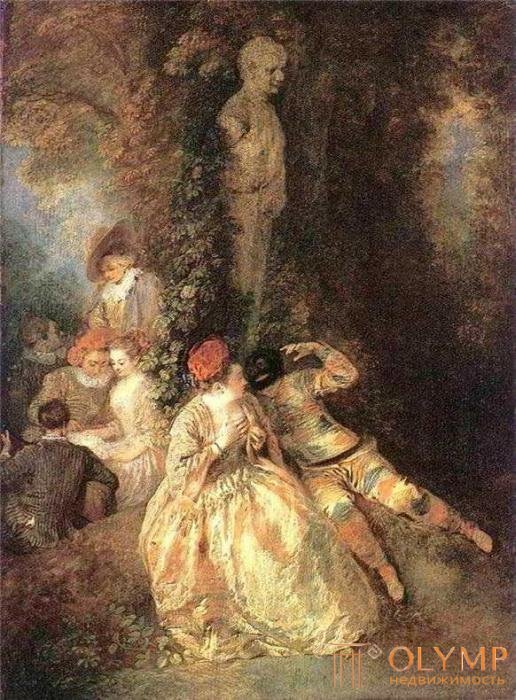
During his short life, Watteau created a new art that, during the entire 18th century, found numerous imitators who had never attained, however, its height. Of his earliest followers, Nicolas Lancre (1690–1743), Watteau’s fellow practitioner in Gillot’s workshop, gives the impression of a weak imitator, and his student Jean Baptiste Joseph Pater (1696–1736) approaches his teacher in only a few of his most successful works.
Next to the idealist Watteau genre, Jean Simeon Chardin (1699–1779), reviving the aspirations of the Lenin brothers, restored realistic genre painting. Goncours and Lady Dilke wrote about him, and lately Daio, Valla and Pilon. His teacher, church painter Pierre Jacques Kaz (Cazes; 1676–1754), a pupil of Bon Bullon, hardly had a great influence on his artistic development. Through his own observation of nature, Chardin developed primarily into the most subtle of the French painters of the dead nature. With a broad, soft and juicy brush he wrote the dead nature of every kind, always distinguished by his simplicity and naturalness of composition and harmony of color. His "Kitchen Supplies" with a cook excited in 1728 in Paris such admiration that he was admitted to the academy with the title "Painter of Flowers, Fruits and Characteristic Plots" for this picture and the "Fruits" of the same year. Both paintings belong to the Louvre. By attaching to his kitchens a figure of a cook, he turned them into genre paintings from the life of Paris citizens. “Cook” (galleries of Liechtenstein, Munich Pinakothek), “Housekeeper” (Louvre), “Prachka” (Stockholm), “Embroidery Lesson” (Louvre, Stockholm), “Prayer before dinner” (Louvre, Hermitage, Stockholm), “Girl sealing letters ”(Potsdam) and“ Girl reading a letter ”(Stockholm),“ Mother dressing a child ”(Stockholm) make up the artist’s favorite subjects. He almost never tries to move a calm state into action. The feminine character of the century is answered by a sharp preference given to them by simple female figures. He portrayed men extremely rarely (among such exceptions is the “Fig. Valschman”, one copy of which is located at the German emperor, the other in the Stockholm museum). Among the 30 Louvre paintings are 20 with a dead kind, one among Stockholm. Five paintings with a dead kind, but not a single genre of his brush, belong to the Karlsruhe gallery.The clean, tranquil homely world that Chardin’s paintings breathe present a complete contrast with the excitement of the secular atmosphere in the works of the Watteau School. Placed on a simple background of the wall of his image, calmly and always picturesquely executed, are distinguished by their elegant cold colorful gamut. His paintings, however, no one would take for the Netherlands. These are the authentic French of the eighteenth century, as well as the creation of Watteau; the world into which they introduce us is another French world.
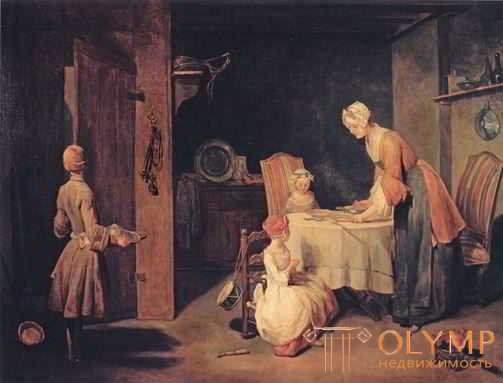
Fig. 209. "Prayer before dinner." Painting by Jean Simeon Chardin in the Louvre.
Под влиянием наполовину Ватто, наполовину Шардена также и Жан Франсуа де Труа, собственно исторический живописец, стал в довольно преклонном возрасте писать жанровые картины, домашнюю жизнь высших кругов общества, не в идеальном духе Ватто, а в реалистическом Шардена, но без силы и своеобразия этих мастеров. Примером можно привести его «Завтрак с устрицами» в Шантильи и «Любовное поручение» в собрании германского императора.
Of the students of Lemoine, who represented bright colors in the Salon of 1737, Charles Joseph Natoire (1700–1777) should be named first, and we will leave large canvases aside to give him a rococo painter with a light temperament, manifested primarily in his graceful scenes from the life of Psyche in the upper wall panels of one of the rooms of the Hotel Soubise adorned by Boffran. The oval paintings abounding in Amur’s oval in Stockholm, with the love story of Apollo and Kletii, were painted in 1745 for the upper panels of the Royal Castle in Stockholm. The light pink tone he borrowed from Lemoine; the cupids with which he decorates his paintings tell them the French grace and gaiety.
3. Creativity Francois Boucher
Francois Boucher was one of the most famous French painters who worked with mythological and genre scenes. Despite the criticism of contemporaries, he is considered one of the main representatives of the national trend in painting.
Three years later, the younger fellow practitioner in the workshop of Lemoine, François Boucher (1703–1770), gained greater fame than Natoire, in numerous, always decoratively conceived, covering all areas of the plot, paintings and engravings reflect with striking clarity the well-known external aspects of the French character of the XVIII century - the thirst for love and life pleasures, distinguishing society, his passion for fun and empty pleasures, his frivolity and superficiality, "Painter of Graces" showed his era, in the words of Andre Michel, her The image in the mirror entwined with garlands of roses. It was Bush, no matter how he was praised by his friends, who was earlier than others, already criticized by Diderot, was overthrown from his pedestal, to be a negative example for almost a century. The same Bush, quite the son of his age and his people, was again glorified by art criticism of the last fifty years (Goncourt, Manz, Andre Michel) and glorified as the most French master of French national art. Where his paintings, as in the Louvre, Stockholm and the Wallace Gallery, hang among the masterpieces of other artists, we will always be repelled by their cold, empty, surface design and execution. But when it is an opportunity to see them as decorative works, in their present place, one cannot but admire the ease and grace of their composition, the grouping of figures and the seething life that fills them. The Amurchiki, which Bush partly painted and engraved separately, for their own sake, engaged in various graceful fantasy affairs, partly scattered around all his large canvases, attached to his art one of those Hellenistic-Alexandrian features that always return to spirit-related eras.
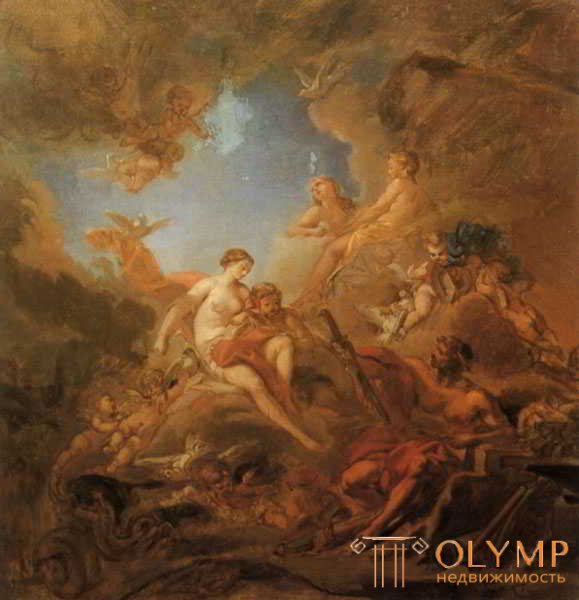
Fig. 210. "Venus and Volcano". Painting by Francois Bush in the Louvre.
The fact that this purely French trend found followers and lovers until the very beginning of the 19th century is testified by two of its kind by significant artists, Jean Baptiste Greze (1725–1805), the new monographs of which belong to Per Mocler and Marcel, and Jean Honore Fragonard ( 1732–1806), about which Portalis, Nake, Nolac, Daio, and Valia wrote. Grez studied painting in Lyon, but was mainly due to the development of his talent in Paris. Like Chardin, he is known primarily as a painter of the bourgeois genre, but, in contrast to Chardin, he was not content to convey everyday events with the most possible pictorial perfection without any tendency, but sought, in Diderot's spirits, who excessively complimented him him, depict dramatic and pathetic events, always with accusatory or sentimental wit. Already his first paintings exhibited in 1755 in Paris, especially the “Father of the Family” reading the Bible, caused a huge sensation. The original of this painting is in the Bartholdi Delesser collection in Paris. The most famous works of his kind, mostly clear in composition and lively, but devoid of special colorful charm of the letter, belong to "Betrothal", "Father's curse", "Broken pitcher" and "Thrush" in the Louvre, in which by 1909 Twenty-three paintings of his hand, The Broken Jug of the Wallace Gallery in London, where twenty-one works of Gröza, The Morning Prayer in the Montpellier Museum storing eleven of his paintings, and Paralytic in St. Petersburg have already gathered. Higher in a picturesque attitude than these genre paintings are his semi-portrait, in-kind busts and heads of flowering, graceful, sometimes roguish-flirty, then naive young girls and children, who even in the Louvre and the Wallace Gallery make up the majority of his paintings. The most beautiful of them all is the "Girl with a Dog" in the Museum of the city of Angers. The undeniable scenic beauty of these images is not free, however, from the sweetness. These are typical “to the public” paintings, written for sale, like so many similar works of the nineteenth century.
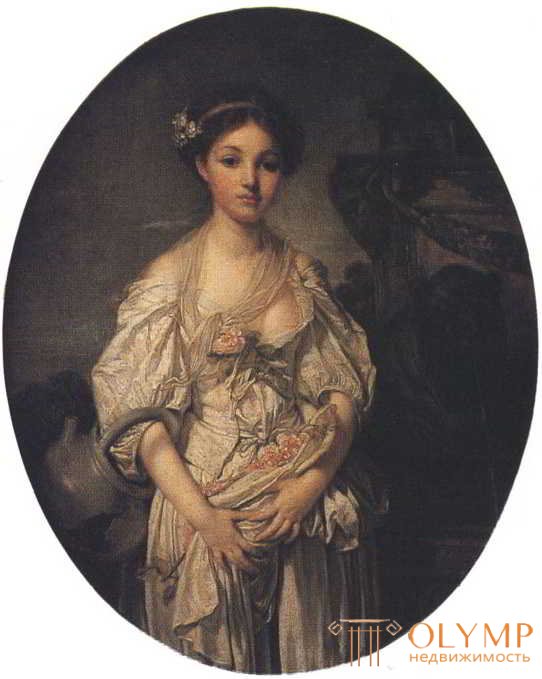
Fig. 211. "The Broken Jug". Painting by Jean Baptiste Dreams in the Louvre.
Fragonard was the most outstanding student of Bush, although he was also influenced by Watteau and Chardin. He wrote ideal, mythological and realistic genre paintings, pastorals and landscapes, like his predecessors, but at the end of the century, like Watteau at the beginning, in everything he did, he was above all a painter, a master with enchanting, very bold brush, always necessary and inspirational paints, clothe it often free-plots, sketched a very lively pattern.
Of the thirteen Louvre paintings, “The Bathers” reveal all the fervor of his artistic fantasy, “Love Date” is typical of his whole manner, and nine paintings by Wallace, of which “Swing” are reproduced in Delone’s engraving, “Love source” - Reno engraving, is shown by Fragonard in its present environment. He himself engraved, according to Goncurov, twenty-six sheets, of which eleven are independent compositions, which all breathe in the same spirit and are distinguished by the same fine technique as his paintings. His drawings for La Fontaine's Fragonard's "Stories" belong to artists who survived their fame and once again restored to the rights of posterity.
4. Other outstanding French painters
In the second half of the century, many great masters of various genres worked in France. In the last years of the 18th century, there was a departure from the previously dominated rococo style and a return to classical motifs.
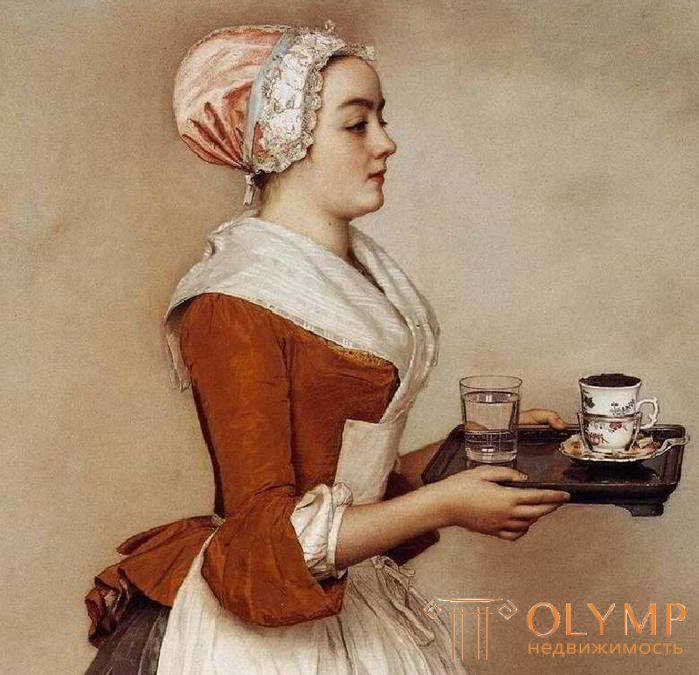
Shokoladnitsa - Jean Etienne Lyotard
Latur's rival, Genevant (1704-1789), who worked in almost all European capitals, but mainly in Amsterdam, in whose State Museum there are twenty-four portraits in pastel, is not equal to him in the vitality of facial features or in full expression, and only because of the soft, delicate manners he belonged to the favorite painters of his time. The most popular of Lyotard's paintings is light in tones, fresh and neatly executed by the "Vienna Chocolate Woman" of the Dresden Gallery. His few oil paintings are mostly in private collections. Correggio was his ideal. The biography and evaluation of the works of Lyotard will be found in the works of Humbert, Revilio and Tilanius.
Elizabeth Louise Lebrun, nee Vige (1755–1843), whose autobiography paints us more vividly than the monograph on her, belongs to her easy flowing manner of design and writing to the style of the 18th century. The change of fashion of a half-century was reflected in her portraits. With all the courtyards of Europe, she wrote the crowned heads, fashionable beauties and famous men. Her best works are in the Louvre, where of the eight paintings her hand especially admire her both self-portrait and daughter. If she lacks the personal strength of character and the deep brush of a true great master, yet her portraits are always painted in an elegant and tasteful manner; these qualities guarantee and now the success of the powerful.
Then comes the time of pseudo-classical reaction for French painting. The most classic of the French classics, Jacques Louis David (1748–1825), with his fellow practitioners Vincent and Reno, stands high above the Parisian art of the first quarter of the 19th century. His transitions from one style to another are depicted by Fr. Benoit For us, in this department, the teacher of the three above-named artists, Count Joseph Maria Wien (1716–1809), himself a student of Natoire, matters. Not so much because of his scientific conviction, but in his temperament, Vian refused from the contemptible and affective style of his contemporaries to return to natural simplicity, which he did not identify with the antic, and although, as the Louvre paintings show, he lacked strength to bring about the coup that seemed to him, his students precisely in him saw the artist turning, as he was known. His first follower, but not a student, was Jean-François Peyron (1744–1814). His "Burial of Miltiades" (1782) in the Louvre shows that although he looked at the antique through Poussin's glasses, he belonged to a small circle of those who in the 18th century consciously fought with the rococo that prevailed.
Что бы оставить комментарий войдите
Комментарии (0)